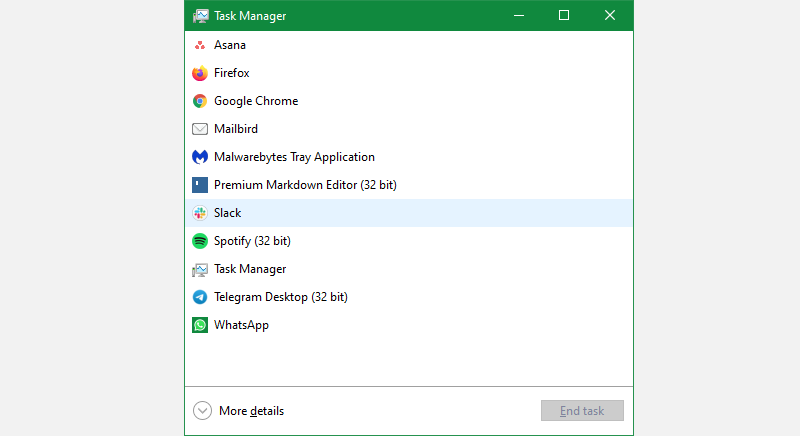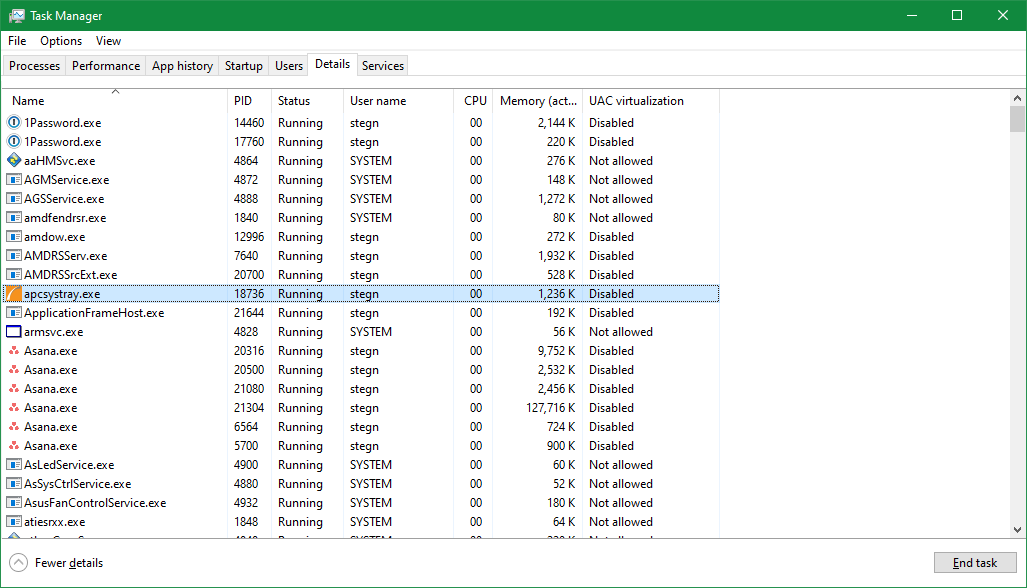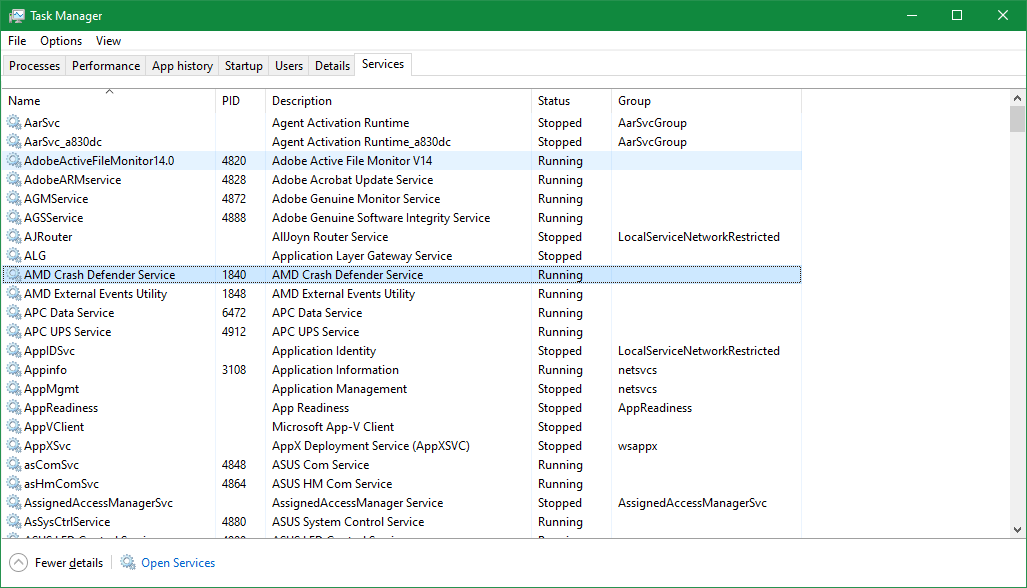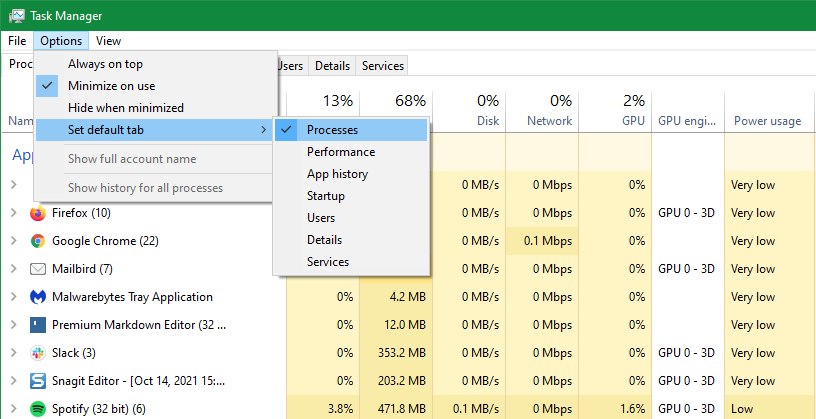You might only open the Windows Task Manager to close programs that freeze, but it's useful for much more than that. The Task Manager provides you with lots of information about your system, as well as management options.
Let's take a tour of the Task Manager in Windows so you know how to use this important utility.
What Is the Task Manager?
The Windows Task Manager is a system monitor utility, meaning it allows you to manage all the processes running on your computer and view other key information. You can order these process by usage to see what's taking up your computer's resources.
The Task Manager has lots of other data too, making it a useful place to visit when you need to check something about your PC. It's not the only utility you'll ever need, but it's a good first stop for general management.
How to Open the Task Manager
You might be used to opening the Task Manager with Ctrl + Alt + Delete. However, this isn't the most efficient way to open it in modern versions of Windows.
This three-button command is a special Windows shortcut that opens the Windows Security page, containing shortcuts to lock your PC, sign out, open the Task Manager, and more. It's also used for secure sign-in, since only Windows can respond to this particular shortcut.

Instead, when you want to open the Task Manager, the fastest method is pressing Ctrl + Shift + Escape on your keyboard. In case you don't like keyboard shortcuts, right-click on an empty spot on the taskbar and choose Task Manager to open it. If you plan to use the Task Manager often, right-click its icon and choose Pin to taskbar for easy access.
There are many other ways to open the Task Manager, if needed. Once you have it open, you might see the simplified interface, which only has a list of running apps. With this, you can select an app and hit End task to kill it, but you'll need to click More details to access the full Task Manager interface.

How to Use the Windows Task Manager
Let's go through the Task Manager, tab by tab. We'll see what each tab offers and how to use the information it provides.
The Processes Tab

On Processes, you'll see a list of everything running on your computer. These processes are divided into three sections when sorted by Name:
- Apps are any programs that you've opened and are currently running.
- Background processes represent everything that's working but not explicitly open as an app. You might see cloud storage services or background apps like clipboard managers here, for example.
- Windows processes contains system services that the OS needs to run properly.
Click any of the header fields at the top, like Name or CPU, to sort using that information. Each heading shows the total amount of that resource in use, along with a breakdown by process.
Drag to rearrange these headings as you see fit. To add more or hide some, right-click anywhere in the headings and check the ones you'd like to see.
Right-click on any process to see options for it. Since the Task Manager groups all processes for an app into one listing, you'll need to click the small arrow to show and manage them individually.
Useful items in this menu include End task to kill an unresponsive app, Open file location to see where the process lives on your computer, and Search online to get more info about unfamiliar processes.

While this menu is handy for closing frozen apps, be aware of Task Manager processes you should never kill.
The Performance Tab

Next, on Performance, you'll see graphs representing the various resource pools of your PC. These include the CPU, Memory, and GPU. Click a field to see a live graph of its usage.
Each field here also contains information about the component it represents, which is useful for checking your PC specs. For instance, on the CPU page, you'll see your processor model listed at the top, plus an Up time field that shows how long since your PC last restarted.
If you'd like to keep an eye on these while doing something else, right-click in the list of items on the left and choose Summary view. You can then keep it open while playing a game, working in a CPU-heavy app, or similar.
For additional details, click Open Resource Monitor at the bottom of this page to open a more advanced utility.
The App History Tab

App History does just what it says: it provides historical data on what resources apps have used. You'll see the total time the app was using the CPU, along with network usage. The data covers the last 30 days.
Unfortunately, this panel is limited to Windows 10 Store apps, so it doesn't include data about standard desktop software. However, it can still clue you into apps that are working too much in the background.
The Startup Tab

Startup is one of the most useful panels of the Task Manager. It lists all the apps set to run when you log into Windows.
Apps often set themselves to run at startup, even if you didn't explicitly ask them to. While this is convenient for programs you use all the time, having apps you don't need run right away slows your boot and wastes background resources.
Have a look through the list to find apps that you don't need to run at startup. For each one, click it and hit Disable in the bottom-right corner.
It's smart to keep security, backup, cloud storage, and similar apps running at startup. But you probably don't need Skype or iTunes to launch as soon as you log in.
The Users Tab

The Users panel is only useful if you have more than one account currently signed into your PC. When you do, you'll see the resource usage for each of them, similar to the Processes tab. Click the arrow next to a user to expand all their processes, where you can get more info or end them, as discussed above.
Aside from this, you're able to right-click another user to force them to sign out.
The Details Tab

Advanced users will appreciate the Details tab; it expands on the information presented in Processes. By default, you can see the process ID (PID), initiating user, and process name for each item. Right-click in the headings and choose Select columns to choose from many more options.
When you right-click a process, you'll see more options, such as setting its priority or ending the entire tree of processes. But most normal users shouldn't need to worry about this. If you need a lot more information than the Processes tab can provide, consult this page. Otherwise, feel free to skip it.
The Services Tab

The Services section of the Task Manager is a slimmed-down version of the Services utility, which you can open by typing "services" into the Start menu. Services are background processes that Windows or other system utilities run to handle various tasks. For example, wuauserv is related to Windows Update.
You shouldn't need to play with the items here in most cases; messing with services without knowing what you're doing could cause problems. If you're really interested, we've looked at Windows services that are safe to disable.
Task Manager File, Options, and View
A few options on the Task Manager's menu bar round out its offerings.
Read more: Windows Task Manager Tricks You Probably Didn't Know
By choosing File > Run new task, you can start a process on your PC (similar to the Run dialog). This is useful when, for example, you need to close and reopen the Windows Explorer task. Just type "explorer.exe" into this menu to launch Explorer anew.
Under Options, you can change a few small behaviors of the tool. Always on top will keep the Task Manager above all other windows, which is useful if you need to see it for troubleshooting. Use Set default tab to choose which menu opens when you launch the Task Manager.

Finally, under View, you can force a refresh of the data with Refresh now and pick how often refreshes happen automatically with Update speed. Disable Group by type if you don't want the Processes tab to use the sections discussed above. Expand all and Collapse all will change all process groups at once.
Master the Task Manager
The Task Manager isn't the most exciting part of Windows, but knowing how to use its tools is part of being a knowledgeable Windows user. Now you know where to go when you want to view your PC's resource usage, change startup programs, or take a dive into active processes.
If you like the Task Manager but want more, there are plenty of more powerful alternatives to the Task Manager.
